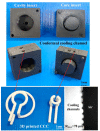Improving Cooling Performance of Injection Molding Tool with Conformal Cooling Channel by Adding Hybrid Fillers
- PMID: 33920123
- PMCID: PMC8069664
- DOI: 10.3390/polym13081224
Improving Cooling Performance of Injection Molding Tool with Conformal Cooling Channel by Adding Hybrid Fillers
Abstract
Silicone rubber mold (SRM) is capable of reducing the cost and time in a new product development phase and has many applications for the pilot runs. Unfortunately, the SRM after injection molding has a poor cooling efficiency due to its low thermal conductivity. To improve the cooling efficiency, the thermal conductivity of the SRM was improved by adding fillers into the SRM. An optimal recipe for fabricating a high cooling efficiency low-pressure injection mold with conformal cooling channel fabricated by fused deposition modeling technology was proposed and implemented. This study proposes a recipe combining 52.6 wt.% aluminum powder, 5.3 wt.% graphite powder, and 42.1 wt.% liquid silicon rubber can be used to make SRM with excellent cooling efficiency. The price-performance ratio of this SRM made by the proposed recipe is around 55. The thermal conductivity of the SRM made by the proposed recipe can be increased by up to 77.6% compared with convention SRM. In addition, the actual cooling time of the injection molded product can be shortened up to 69.1% compared with the conventional SRM. The actual cooling time obtained by the experiment is in good agreement with the simulation results with the relative error rate about 20%.
Keywords: cooling time; filler; relative error rate; silicone rubber mold; thermal conductivity.
Conflict of interest statement
The authors declare no conflict of interest.
Figures

























References
-
- Kalami H., Urbanic R.J. Design and fabrication of a low-volume, high-temperature injection mould leveraging a ‘rapid tooling’ approach. Int. J. Adv. Manuf. Technol. 2019;105:3797–3813. doi: 10.1007/s00170-019-03799-8. - DOI
LinkOut - more resources
Full Text Sources
Other Literature Sources

